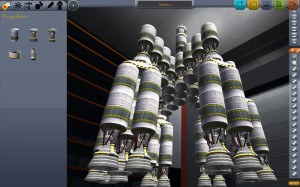Gaming would not be where it is today were it not for science. Specifically, computer science, but science none the less. I promise I will not start rambling mercilessly about the history of the microchip or go on for days about how Ada Lovelace is technically the first programmer, but I do get a bit giddy in the pants when I see two of my longest friends, video games and science, start making eyes at each other. When those two are in a room together and the moon is just right, the potential for glorious things is palpable. However, they do not always get it right. Considering the marriage of science and gaming is something I would love to see more of, I will attempt to articulate exactly what I would like to see happen.
I feel obligated to begin with Kerbal Space Program. It may seem like I am blowing my perfect example wad too soon, and that is probably true. In my mind, KSP speaks with a booming authority when I think of games that are not only fun to play, but have provided a playground in which to exercise my pudgy brain. There is a reason I list it as one of my favorite games, and that is because Squad is not screwing around when it comes to the implementation of the game’s physics. This actually put me in a position to taste some maths in order to better understand the orbital mechanics. That I found myself set to employ Newtonian Laws to augment my rocket skills had me chuckling at how far things have come since the edutaining Reader Rabbit. The point is that things were being learnt, and it was happening in both a challenging and enjoyable environment.
What is a little disappointing about the copulation of gaming and science is that, as it stands, the Citizen Science movement seems to not really be grasping the idea they would probably garner a broader audience with their apps if said apps were fun. Casting aside my own Puritanical bent of what people ought to be devoting their free minutes to, I can not even begin to deny the rich trove of data that could be collected if the user experience included entertainment value. I am personally very interested in many of the projects out there, but I also know that a good chunk of people associate science with tedium, and perhaps they are correct to a degree. In modern video games, there is an opportunity to show those folks otherwise.

“Why yes, this image DOES look slightly different from the last one!” – said every Citizen Scientist
Before I continue, I should briefly define what the Citizen Science movement is. At its most basic, it is crowd-sourcing various tasks, typically in an effort to either train (the loose definition of the word) a better computer to do something, or harness the vast computing power of the incredibly bored. While there are a variety of projects from different fields available to participate in, the fact is that any participant will generally be asked to click something or other on an endless slideshow. A great example would be CERN’s Higgs Hunters. Particle physics is easily one of the most fascinating things I can think of, but I only lasted about twenty images before I realized I could be putting forth similar efforts and getting paid for it by logging on to Amazon Mechanical Turk.
Getting back on track, Citizen Science might not be able to match the fun factor of something like KSP, but a little effort to do so probably would not hurt. Take the California Academy of Science’s iNaturalist, for example. With a dash of imagination, and a peek at Pokémon, it is not difficult to see how this could be a way to engage people who tend toward apathy when it comes to dabbling in nature studies.
There is a plethora of these types of projects going on out there, and I suppose I have to admit that the people leading these projects are not completely dead to the idea that it could be more amusing to the user. I have not had the chance to try the offerings, but Citizen Sort bills itself as entertaining, even going so far as to use the words ‘video game’ as opposed to ‘app.’ The point is that the technology to develop a simulator suitable for entertainment, education, and research data harvesting exists to a degree. It just boggles me as to why it is not being exploited for just such a purpose.
Of course, NASA, my third favorite acronym, might be upping their game. I am actually very surprised that I got this far in the article without bringing them up. NASA is no stranger to placing the opportunity to participate in science at the fingertips of curious people everywhere, and video gaming has been on their to-do list since at least 2010 when Moonbase Alpha arrived on Steam. Sure, Moonbase Alpha was probably the number one game to make fun of for a hot minute there, and that is the only reason I link to the Steam page. Bup might appreciate some of the comment gems that can be found about the game’s issues, accompanied by a deceptively high rating of arbitrary stars.
NASA’s next attempt was to be an astronaut MMO aimed at finally using their “position to develop an online game that functions as a persistent, synthetic environment supporting education as a labratory.” Now that is what I like to hear! Sadly, after some studio debacles and other weirdness, we seem to be left with a twenty minute prototype for…something…in the form of Starlite: Astronaut Rescue, a lamentable flop that nobody should be okay with. It actually pains me to link to such wasted potential. Then again, NASA holds to the principle that failure is a fine tool, so perhaps they should just bed down with Squad, and attempt to merge science and gaming the correct way.
Well, I have made myself sad again, so it looks like I will be firing up KSP soon to scratch that edutainment itch. Hey, while we are here, let us fantasize a bit, shall we? Invent a game of science within the limits of your own imagination. What would it be? Mine would probably be some simulated version of Fantastic Voyage combined with NanoDoc’s goal of arming nanoparticles and observing their behavior against cancer cells, tweaking and strengthening my micro-army as the game progresses.

